Atlantic Monthly Contributors's Blog, page 123
July 12, 2016
Meeting Refugee Goals

The U.S. is one step closer to meeting its goal of accepting 10,000 Syrian refugees this fiscal year.
The U.S. State Department, in new figures released Tuesday, said 2,406 Syrian refugees entered the country in June. Over the previous eight months, a total of 2,805 Syrians were accepted. In all, with three months to go in the fiscal year, which ends September 30, the U.S. has accepted 5,211 refugees.
Last year, President Obama pledged to take in 10,000 Syrians amid the massive refugee crisis spawned by that country’s civil war. But the U.S., unlike European countries reeling under the influx of the newcomers, has a strict standard on the refugees it lets in. The U.S. can reject asylum-seekers on grounds such as health, criminal activity, and links to terrorism. As I’ve previously reported:
The process of bringing refugees to the U.S. is handled by three agencies: the State Department, which leads the program, USCIS at the Department of Homeland Security, and the Office of Refugee Resettlement at the Department of Health and Human Services. …
It takes anywhere from 18 to 24 months or even longer to process a case from referral or application to arrival in the U.S.
With Tuesday’s figures, the U.S. has three months to admit another 4,789 Syrian refugees to meet Obama’s goal.
In a statement, Eleanor Acer of Human Rights First said: “The Obama Administration has made progress in addressing some of the backlogs and delays that have hampered its ability to resettle refugees, but with three months left in the fiscal year, it is still far from meeting its goal of resettling at least 10,000 Syrian refugees this fiscal year.”
The 10,000 refugees represent about 0.2 percent of more than 4.8 million refugees created by the more than five-year-long Syrian civil war.

The Bleak Cynicism of Mr. Robot
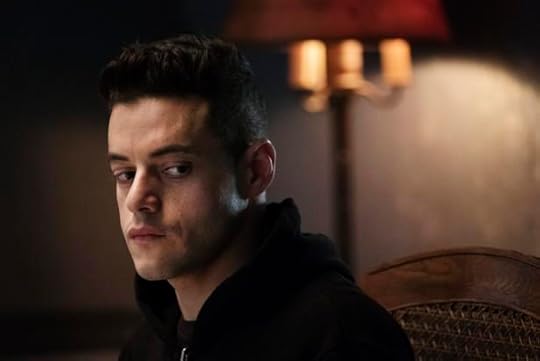
You might wonder, watching the past few years of prestige television, if drama is having an identity crisis. As comedy increasingly encroaches on its territory, tackling subjects like depression, captivity, racism, abortion, and mass shootings with sensitivity and intellectual heft, drama seems to be compensating by going full-throttle toward bleakness. Season two of Netflix’s Daredevil was a gory, 13-episode slog through mutilated body parts and sexualized torture; Starz’s The Girlfriend Experience made the story of a high-class sex worker into chilly psychological horror; True Detective’s sophomore season seemed to mistake brooding intensity and seething darkness for narrative cohesion and recognizable dialogue. TV’s grimness has even been echoed in film, with Zack Snyder’s Batman v. Superman being pilloried by critics for its unrelenting self-seriousness.
Sometimes bleakness pays off (The Americans), and sometimes it doesn’t (True Detective). But rarely does it feel as accusatory as it does in Mr. Robot, the USA hacker drama that became a surprise hit last summer and even beat out Game of Thrones for a Golden Globe. Elliot (Rami Malek), the psychologically troubled antihero of the series, rails constantly against the corrupted trappings of modernity—corporations, capitalism, government surveillance, et cetera. But he’s also infuriated by everything he feels excluded from, which includes society. Malek’s Elliot is so beguilingly vulnerable onscreen that he entices viewers into identifying with him. But that often means we root against ourselves: In the universe of Mr. Robot, which is even darker and more joyless in season two, it increasingly feels like the audience might be Elliot’s enemy.
Whether or not this feels refreshingly cynical or ideologically irritating will probably depend on your tolerance for the stylized hallmarks of Mr. Robot’s first season—electronic music that lurks insistently in the background then crescendoes to illustrate Elliot’s mental fragility, extended shots that swoop over and around their subject as if stalking it, filters that render every scene pallid and antiseptic. Another mainstay is the show’s distinctive treatment of viewers—Elliot regularly breaks the fourth wall to speak directly to us, and share thoughts he can’t share with others—but while the audience was framed as a confidante in season one, now we’re an antagonist. “Hello again,” Elliot says midway through the first episode of season two. “I don’t know if I can tell you secrets like before. Friends are supposed to be honest with each other, and you weren’t.”
Mr. Robot is created by Sam Esmail, who wrote the majority of the episodes in the first season. Its sprawling and perhaps deliberately confusing plot traced Elliot’s path from a socially reclusive, morphine-addicted programmer to the architect of a scheme to erase public debt that ultimately disrupts the global economy. Recruited into a group of anarchic hackers called fsociety by the mysterious Mr. Robot (Christian Slater), Elliot eventually came to realize that Mr. Robot was an extension of his own mind—a Fight Club-inspired twist that reveals how fragile Elliot’s psyche was, and how unreliable he was as a narrator. As fsociety’s plan to hack a bank/monolithic institution named E Corp escalated, so did Elliot’s mental breakdown, culminating in the final episode of the season, where he woke up in an SUV three days after the hack was executed, with no memory of how he got there or what happened.
Season two is directed in its entirety by Esmail, and thus feels more auteur-driven, sometimes to its detriment. It does promise to fill in some gaps—one of the first scenes shows Elliot working with E Corp’s disgraced and homicidal CTO, Tyrell Wellick, to precipitate the hack that takes down the corporation. But with Elliot’s mental state as precarious as it was at the end of last season, it’s almost impossible to discern what’s real and what’s a figment of his psyche. A month after the hack (now referred to in calamitous parlance as 5/9 for the date on which it happened), he seems to be living in self-imposed exile away from computers, sticking to a routine that involves three meals a day in a diner with his new friend Leon (played by the rapper Joey Bada$$), watching basketball in the park, and going to group meetings in a church. But he still sees Mr. Robot, who’s now a full-blown antagonist enraged by Elliot’s digital detox.
It’s doubtful how long Elliot’s period of isolation can last, given that the FBI is investigating the attack (Grace Gummer joins the series as an agent pursuing Elliot’s old boss). As the ramifications of the hack play out, it remains questionable how much good it actually did, and whether E Corp was in some way involved all along. Part of the problem is that Elliot’s worldview allows for only seeing flaws, not solutions: In his inner monologue, he indicts both “the infinite loop of insanity” that defines his own existence and the comfortable “sameness” that most people experience in daily life, “to go along with their NCIS and their Lexapro.” He despises capitalism and selfishness, but is also deeply uncomfortable around people. The hack he executed to free people from debt led to a global financial crisis, as well as countless E Corp customers being unable to prove that they’d ever paid any of their bills.
There are some outstanding moments in season two that testify to Esmail’s ingenuity. A scene in which one of E Corp’s lawyers is attacked in various ways (scalding shower, blasting music, incessant burglar alarm) by her SmartHome is tech-driven psychological horror that communicates fraught anxieties about a hyperconnected world. Joey Bada$$ offers fleeting moments of humor as a Millennial who’s only recently discovered Seinfeld. One climactic scene plays out in a park to the soundtrack of Phil Collins’s “Take Me Home,” in what seems to be another deliberate nod to American Psycho. Elliot’s childhood friend Angela (Portia Doubleday) is suddenly sphinx-like in her new job doing public relations at E Corp, hypnotizing herself with inspirational slogans that preach success.
But Elliot’s indictment of modern life—of cellphones and Facebook and wine bars and office jobs and 401ks—is presumably also an indictment of people who watch critically acclaimed but low-rated thrillers on cable television. This is a subversive move for a TV show to make, and many of Elliot’s rants feel alarmingly akin to someone screaming, “WAKE UP SHEEPLE” on an InfoWars message board.
Season one worked because in its earlier episodes Elliot seemed a little like a superhero, using his hacking powers for good(ish) to get child pornographers arrested and to let his therapist know that her boyfriend was married. It also had a deliberate narrative structure that led toward a singular event tied to its protagonist’s mental state (much as Homeland links all major global terror attacks to Carrie forgetting to take her meds). Now, things are much murkier, and the question of whether the show will recover its focus or remain mired in psychological trauma will define whether season two succeeds or fails. Malek’s hollow-eyed charisma can redeem a hero who’s deeply troubled but essentially noble in purpose; it can’t carry a show whose defining quality is cynicism.

Obama: ‘We Are Not as Divided as We Seem’
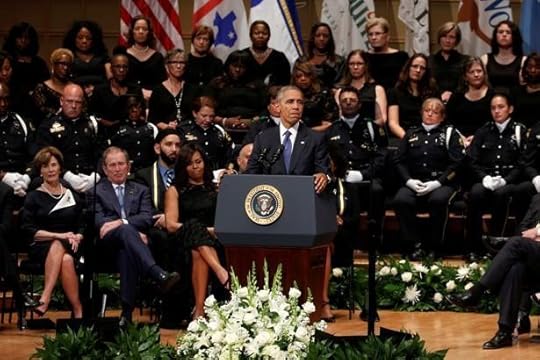
Updated at 4:27 p.m. ET
Two American presidents came together to mourn what happened in Dallas last week.
President Barack Obama and former President George W. Bush appeared at a memorial service Tuesday for the five officers shot and killed while protecting demonstrators at a city protest. Obama’s remarks were the most effusive he’s given in this past, violent week. Just days ago, Obama addressed the nation about the shooting deaths of two black men by police officers. He was overseas at the NATO Summit when the shooting began in Dallas, and cut his visit to Europe short to prepare for Tuesday’s services.
In his remarks, delivered at the end of the ceremony, Obama said Americans’ “entire way of life … depends on the rule of law,” and that the officers killed last week “were upholding the constitutional rights of this country.” Even though some protesters were critical of police, “these men and this department did their jobs like the professionals that they were.” The officers honored Tuesday are Lorne Ahrens, Brent Thompson, Patrick Zamarripa, Michael Krol, and Michael Smith.
The New York Times reported that Obama had “hop[ed] to find words that would not only console the officers’ grief-stricken families but also reassure a nation fearful that racial divisions are worsening.” His eulogizing role isn’t anything new. As George Condon wrote in National Journal two years ago—before Obama sang “Amazing Grace” at the funeral of Reverend Clementa Pinckney in Charleston, before he honored victims of the Navy Yard shooting in Washington, D.C.—the president’s public appearances in times of public sorrow are a “routine all too familiar” to Obama:
[His] time in office has been marked by an unusual number of deadly natural disasters and far too many funerals and memorial services after several mass shootings and one terrorist bombing. Starting with his trip to Beckley, West Virginia, April 25, 2010, to deliver the eulogy for 29 miners killed in a coal mine explosion, the president has made such somber treks far more often than he would like. He has viewed storm damage in Alabama, Louisiana, Mississippi, Missouri, New Jersey and New York. He has gone to communities shaken by gun violence in Arizona, Texas, Colorado and Connecticut. And, most recently, he has prayed with the victims and survivors of the bomb attack in Massachusetts and industrial explosion in Texas. …
[I]n all cases, whether the deaths and destruction result from acts of God or the misdeeds of man, the nation expects its president to provide comfort and solace and to serve as the mourner-in-chief. They also hope that his words will somehow help them make sense of the event that has so disrupted their lives.
On Tuesday, Obama acknowledged his fellow citizens’ pain. “I know that Americans are struggling right now with what we've witnessed over the past week,” Obama said. “All of it’s left us wounded and angry and hurt. [That] the deepest fault lines of our democracy have suddenly been exposed, perhaps even widened.” Americans wonder if racial divides will be fixed, Obama said, as people “retreat to their respective corners” and as lines are drawn. “It's hard not to think sometimes that the center won't hold, and that things might get worse. I understand. I understand how Americans are feeling. But, Dallas, I'm here to say we must reject such despair. I'm here to insist that we are not as divided as we seem.”
In a poignant speech, Bush, who makes his home in the Dallas area, similarly described Americans’ worries, and called for unity. “At times, it seems like the forces pulling us apart are stronger than the forces binding us together. Argument turns too easily into animosity. Disagreement escalates too quickly into dehumanization. Too often we judge other groups by their worst examples, while judging ourselves by our best intentions,” Bush said. But he has hope. “At our best, we practice empathy, imagining ourselves in the lives and circumstances of others. This is the bridge across our nation's deepest divisions. And it is not merely a matter of tolerance, but of learning from the struggles and stories of our fellow citizens and finding our better selves in the process.”
Earlier Tuesday, as he traveled to mark one tragedy, the president remembered others, calling the families of Alton Sterling and Philando Castile—the two men killed by police last week in Louisiana and Minnesota, respectively—from aboard Air Force One. Lawmakers joined him on the plane: Texas Representatives Eddie Bernice Johnson and Marc Veasey, Texas Senator Ted Cruz, and House Minority Leader Nancy Pelosi. Vice President Joe Biden and his wife, Jill; Texas Senator John Cornyn; and Bush and First Lady Laura Bush attended the ceremony as well.
Obama praised Dallas’s police department while describing not only how officers handled the recent shootings, but also their approach to law enforcement—the department is a national model for police reform. Still, Dallas Mayor Mike Rawlings said earlier in the day that city officials had more work to do: “This is our chance to lead and build a new model for a community, for a city, for our country,” he said in his opening remarks.
Obama suggested officers nationwide are overburdened by public underinvestment in some of the communities they serve, echoing Dallas Police Chief David Brown’s own concerns. But Obama spoke frankly of the discrimination, mistreatment, and stressors that African Americans, specifically, face in their interactions with law enforcement. And he asked his fellow citizens to understand those pushing for change. “We cannot simply turn away and dismiss those in peaceful protest as troublemakers or paranoid. You can't simply dismiss it as a symptom of political correctness or reverse racism,” Obama said. “To have your experience denied like that, dismissed by those in authority, dismissed perhaps even by your white friends and co-workers and fellow church members, again and again and again? It hurts.” Obama called for Americans to confront these divisions head-on and with an “open heart,” working toward reconciliation between law enforcement and the citizens they swear to protect.
“I believe our sorrow can make us a better country. I believe our righteous anger can be transformed into more justice and more peace. Weeping may endure for a night but I'm convinced joy comes in the morning,” Obama said. “We cannot match the sacrifices made by officers Zamarripa and Ahrens, Krol, Smith, and Thompson, but surely we can try to match their sense of service. We cannot match their courage, but we can strive to match their devotion.”

Rebranding Infidelity
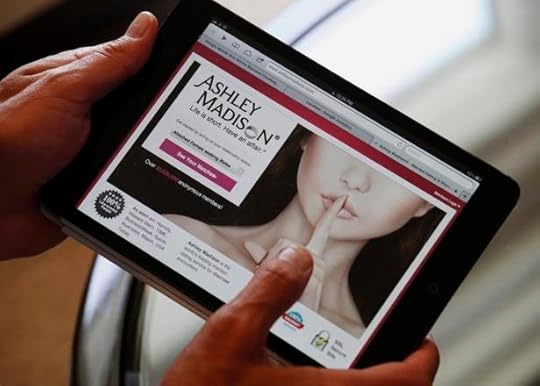
It seems life is no longer so short we should have an affair.
Ashley Madison, the website for cheaters, is out Tuesday with a new ad campaign that drops its infamous tagline, “Life is short, have an affair,” and replaces it with the “UNDERSTATED, ELEGANT” (the caps are theirs, not ours) tagline, “Find your moment.”
The announcement reflects what the company says is a change in how people use the service, according to James Millership, the company’s president.
Close to 45% of our members are single, over 50% are attached and they are interested in a wide range of experiences. While remaining true to our roots, Ashley Madison needs to evolve, grow and attune to modern sexuality in 2016.
Ashley Madison released three new television ads along with its rebranding, showing men and women, married or otherwise, flirting with strangers, primarily through smiling and warm looks, in public places, like so:
In 2015 Ashley Madison dealt with the national embarrassment of having its 37 million users leaked to the public by hackers, which could explain the new ad campaign.
The company behind the Ashley Madison website, Avid Life Media, is also changing its name to “ruby” because the name, according to Millership, “has a sensual, feminine quality, connotes value and fits with the fresh start our company is undergoing.” The “global leader in open-minded dating” will continue its other brands Cougar Life and Established Men.
The rebranding is part of an effort by Ashley Madison to restore its credibility, which was badly damaged following the hack last year. Millership and Rob Segal, the Toronto-based company’s CEO, told Reuters this week that Ashley Madison was the subject of an investigation by the Federal Trade Commission. The two were hired in April. Here’s more:
[Ashley Madison] faces a mountain of problems, including U.S. and Canadian class action lawsuits filed on behalf of customers whose personal information was posted online, and allegations that it used fake profiles to manipulate some customers. The site's male-to-female user ratio is five to one, the executives said.
An Ernst & Young report commissioned by Avid and shared with Reuters confirmed that Avid used computer programs, dubbed fembots, that impersonated real women, striking up conversations with paying male customers.
The two executives told Reuters that the company, which was the subject of much mirth as well as disapprobation, and, presumably, user interest before the hack, was spending millions to improve security. Apparently, in its new guise, Ashley Madison is also trying to find its moment.

The Shaky Basis for Trump's 'Law and Order' Campaign

Donald Trump, grasping for some traction in the polls and for a posture of leadership in the wake of several violent incidents, has landed on a new slogan, telling attendees at a rally in Virginia Beach on Monday that he is “the law-and-order candidate.”
He reprised the line again Tuesday morning on Twitter:
This election is a choice between law, order & safety - or chaos, crime & violence. I will make America safe again for everyone. #ImWithYou
— Donald J. Trump (@realDonaldTrump) July 12, 2016
Like one of Trump’s other favorite phrases, “the silent majority,” this one is borrowed from Richard Nixon’s 1968 presidential campaign. (Trump is an expert recycler of slogans. “Make American Great Again” was first popularized by Ronald Reagan; “America First” was once associated with pro-fascist isolationists, including Charles Lindbergh, in the lead-up to World War II.)
“Law and order” was a potent mantra for Nixon during the 1968 campaign. The nation seemed like it was on fire—and parts of it actually were. In April, Martin Luther King Jr. was assassinated in Memphis. In June, Robert F. Kennedy was killed. Riots swept through major cities. After an unprecedented period of low crime after World War II, the violent-crime rate was in the midst of a sharp rise that would taper off slightly in the early 1980s before rising again, finally peaking in 1991. Americans were afraid, and Nixon’s promise to get tough on crime and stop the growing violence exercised a powerful appeal. (It was a promise he couldn’t fulfill. Crime continued to rise during his presidency.) The second, smaller spike up to the 1991 high is also essential context for Bill Clinton’s own tough-on-crime posture in the 1992 election—an approach for which he, and his wife Hillary Clinton, have been strenuously criticized by activist groups like Black Lives Matter during this election.
Listen to Trump now and you’d think something similar is going on today:
Crime is out of control, and rapidly getting worse. Look what is going on in Chicago and our inner cities. Not good!
— Donald J. Trump (@realDonaldTrump) July 12, 2016
In fact, crime rates in the U.S. have in recent years experienced a major decline:
This chart cuts off in 2012, but the decline has mostly continued. In the first half of 2015, crime rates ticked up 1.7 percent, but they remain well below those historic highs. Criminologists don’t have conclusive answers about what might be driving the tick upward. Although there may be some unsettling parallels with that annus horribilis, 2016 is not 1968. That means Trump is trying to make a case for a year of chaos after more than two decades of steady improvement.
But that may not actually be all that challenging, even if it is counterfactual. First, Americans’ attitudes about violence haven’t tracked actual crime rates over the last 15 years. Even though crime rates fell significantly between 2008 and 2012, there was never as steep a corresponding drop in concern, and worries have actually increased over the last couple years.
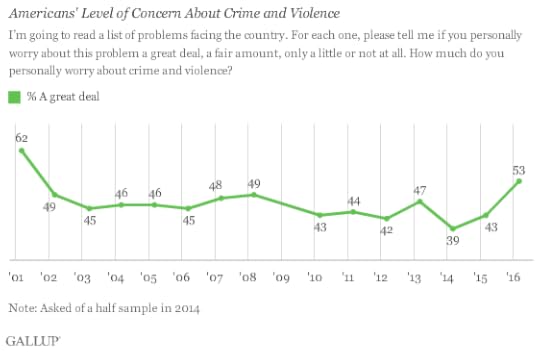
It’s hard to know exactly what’s driving that increase, but there are a few of obvious suspects. One is the increase in non-terrorist mass shootings, which has received a large amount of media attention, but which Trump hasn’t offered much in the way of proposals to stop. A second is the increase in gun crime in some cities, especially in Chicago and in Baltimore, which has also been heavily covered. (Other cities continue to experience historic levels of peace, including Trump’s home town of New York.) The third is the many protests spurred by the killings of African Americans, some of which have involved sporadic violence, including in Ferguson, Missouri; Baltimore; and most recently in Dallas. For activists fighting police violence, these outbreaks are unfortunate or tragic side effects of a necessary movement against police violence.
For Trump, and for his supporters, however, these incidents are the story. Trump has to a great extent taken the side of police in the brutality debate, and on the stump he makes a point of applauding U.S. law-enforcement personnel. Foregrounding unrest makes it seem more prevalent than it is, reinforcing or creating a sense of lawlessness.
Increasing urban crime rates in the mid- and late-20th century were often associated (rightly or wrongly) with the migration of blacks from the rural South into cities. Nixon was skilled at leveraging racial tension and resentment to get white votes. Trump is pursuing a similar strategy. Although Trump insists that “the blacks” and “the Hispanics” love him, his fate likely depends on how well he performs among white voters, given his incredibly low favorability ratings with minorities. That helps explain why, in an interview with the Associated Press, Trump harshly criticized Black Lives Matter, and why he predicted more violence to come. Trump also said that racism is “a bigger problem than people understand,” but he seemed to pin some blame for that on President Obama. In his AP interview, he argued (as he has done before) that black anger can be placated with jobs, while only barely acknowledging that communities of color may have legitimate grievances with the police.
One irony here is that to the extent that there are increases in crime, they’re concentrated in urban areas. (Trump’s use of the dated term “inner cities” in the tweet above is itself a historical artifact.) Rising crime in the 20th century not only elected Nixon; it also drove many whites, especially conservative ones, to abandon cities. The result is that the United States is now strongly polarized between urban areas, which are more racially diverse and vote heavily Democratic, and rural ones, which are whiter and tend Republican. The people who are most likely to be affected by rising violence in city centers are those who are least likely to support Trump. But if talking about “inner-city” crime motivates rural voters to go to the polls and vote for him in November, what does it matter?

When Athletes Take Political Stands
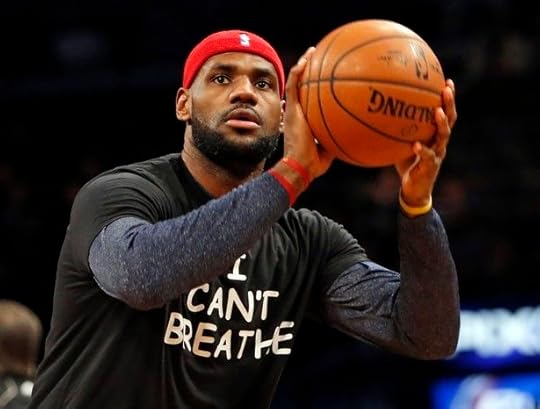
It was a somber moment before the Minnesota Lynx WNBA team took the court on Saturday night. Four players, standing in front of the press before the game started, wore black shirts that on the front said, “Change starts with us, justice and accountability”; on the back were the names Philando Castile and Alton Sterling, the crest of the Dallas Police Department, and the words “Black Lives Matter.”
“If we take this time to see that this is a human issue and speak out together, we can greatly decrease fear and create change,” said Maya Moore, one of the team captains and the 2014 league MVP. “Tonight we will be wearing shirts to honor and mourn the losses of precious American citizens and to plead for change in all of us.”
Moore said they wanted to speak out against racial profiling that many activists said led to the death of Sterling, who was shot in Baton Rouge, Louisiana, and Castile, who was shot last week by a police officer in suburban St. Paul, not far from where the Lynx were playing in Minneapolis. Moore also denounced the “senseless ambush” of Dallas police when five officers were killed by a lone gunman.
Lynx forward Rebekkah Brunson said she was wearing the shirt “to honor and mourn the loss of precious American citizens and to plead change for all of us.”
But their message wasn’t accepted by everyone. Four off-duty Minneapolis police officers, who were working private security at the Lynx game, quit amid the show of activism from the players. Bob Kroll, the president of the union that represents Minneapolis police officers, praised them for walking off the job.
“If [the players] are going to keep their stance, all officers may refuse to work there,” he told The Minneapolis Star Tribune on Tuesday.
But how effective could this threat be? It doesn’t seem to have swayed the players, or the Minnesota Lynx organization. During the news conference, the team was even tweeting some of the players’ quotes, embracing their activism.
"This is a human issue & we need to speak up for change, together." -Maya pic.twitter.com/tyfl65Ag81
— Minnesota Lynx (@minnesotalynx) July 9, 2016
Political activism among athletes is not new. Bill Russell, Jim Brown, Lew Alcindor (who later changed his name to Kareem Abdul-Jabbar), and other black athletes met with Muhammad Ali in Cleveland in 1967 to see whether his objections, at great personal cost, to the Vietnam War as a conscientious objector were serious. That meeting, in which the heavyweight champion would eventually gain the support of the athletes who attended, would later be called the Ali Summit and has remained a pivotal moment in athlete activism.
Curtis McClinton, who played for the Kansas City Chiefs and attended the meeting, would later tell The Cleveland Plain Dealer:
We knew who we were. We knew what we had woven into our country, and we stood at the highest level of citizenship as men. You name the value, we took the brush and painted it. You raised the bar, we reached it. You defined excellence, we supersede it. As a matter of fact, we defined it.
There were other instances, too: During the 1968 Summer Olympics in Mexico City, gold medalist Tommie Smith and bronze medalist John Carlos, two American black runners, raised their black-gloved fists in the air during the playing of the “Star Spangled Banner.” The two men were expelled from the Games for the act.
But this sort of political activism was largely absent among professional athletes in the decades that followed. As President Obama said in 2014, among well-paid athletes there was the notion of “just be quiet and get your endorsements and don’t make waves.” Indeed, Michael Jordan, when asked during his playing days why he wasn’t more political, is reported to have (apocryphally) quipped: “Republicans buy sneakers, too.”
Recently, though, there have been examples of athletes taking a stand on national issues—coinciding with several high-profile cases in which white police officers killed black men.
In 2014, Derrick Rose, who at the time played for the Chicago Bulls, wore a T-shirt that said, “I Can’t Breathe,” the words repeated by Eric Garner as he died while being taken down with a chokehold by Staten Island police. Shortly thereafter, LeBron James and Kyrie Irving of the Cleveland Cavaliers and Jarrett Jack, Alan Anderson, Deron Williams, and Kevin Garnett of the Brooklyn Nets wore the same shirt when they played each other in New York.
James viewed the protest as his obligation as a professional athlete, telling the reporters then:
It’s just to understand what we're going through as a society. I’ve been quoted over and over as far as what's going on, it’s more of a notion to the family. More than anything. As a society we have to do better. We have to be better for one another, don't matter what race you are.
James had previously led a protest in 2012 when he was with the Miami Heat, wearing hoodies to commemorate the death of Trayvon Martin.
Some athletes want more activism from their colleagues on the court and fields. On Friday, New York Knicks forward Carmelo Anthony wrote a long Instagram post, featuring a photo of that meeting between the four black athletes in 1967, urging fellow athletes to do more than just march in rallies or post on social media. It hasn’t worked, he says.
I’m calling for all my fellow ATHLETES to step up and take charge. Go to your local officials, leaders, congressman, assemblymen/assemblywoman and demand change. There’s NO more sitting back and being afraid of tackling and addressing political issues anymore. Those days are long gone. We have to step up and take charge.
We can’t worry about what endorsements we gonna lose or whose going to look at us crazy. I need your voices to be heard. We can demand change. We just have to be willing to.
This sort of activism will inevitably face pushback of the kind seen Saturday night in Minneapolis. Indeed, when Cleveland Browns wide receiver Andrew Hawkins wore a shirt that said, “Justice for Tamir Rice And John Crawford III” before a game in December 2014 to protest the deaths of two unarmed black people, the president of the union that represents Cleveland police was outraged. Jeff Follmer, the union chief, said:
It’s pretty pathetic when athletes think they know the law. They should stick to what they know best on the field. The Cleveland Police protect and serve the Browns stadium and the Browns organization owes us an apology.
The Browns would not apologize. Neither would the St. Louis Rams organization after some its athletes walked onto the field with their hands up, commemorating the protests in nearby Ferguson, Missouri. The organizations supported their athletes’ political expression. As did the Minnesota Lynx organization.

July 11, 2016
A Deadly Shooting in Michigan
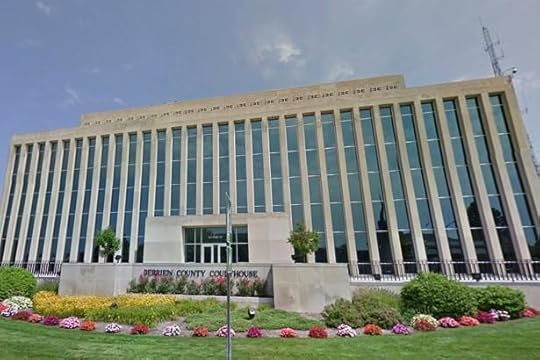
NEWS BRIEF Two bailiffs were killed in a courthouse in southwest Michigan Friday. The shooter was also killed in the incident, taken down by officers on the scene.
Berrien County Sheriff Paul Bailey said in a news conference that the shooting occurred around 2:30 p.m. The suspect also shot a deputy sheriff and civilian outside the courthouse in St. Joseph, Michigan. Both are stable and being treated for injuries.
Michigan Governor Rick Snyder tweeted his condolences later in the afternoon.
Please join me in praying for those affected. We will share more information here from MSP as it becomes available.
— Governor Rick Snyder (@onetoughnerd) July 11, 2016
Local ABC affiliate WZZM reported “a man who was on his way to jail took a gun off a deputy and started opening fire.” Officials, however, have not released further information.
Monday’s shooting occurred amid the backdrop of nationwide unrest over police-involved shootings. The shooting appears to be unrelated to that unrest.

Dallas Police Chief: 'We're All on Edge'

NEWS BRIEF The Dallas Police Department will review more than 170 hours of footage from body cameras worn by police at a demonstration against police violence last week where a sniper killed five officers and injured nine more, the department’s chief said Monday.
Dallas Police Chief David Brown said in a news conference that officials are reviewing 300 witness statements and collecting video footage from body cameras, dashboard cameras, and surveillance cameras at the intersection in downtown Dallas where 25-year-old Micah Johnson opened fire Thursday night. Before he was killed by police, Johnson, who was black, told officers he specifically targeted white police officers because he was upset by last week’s fatal police shootings of two black men, one day apart: Alton Sterling in Louisiana, and Philando Castile in Minnesota.
Brown said he is “running on fumes” as the department investigates the shooting with the help of federal agents and regional law-enforcement agencies.
“We’re all on edge and being very careful,” Brown said.
The slain officers included four from the Dallas Police Department and one from the Dallas Area Rapid Transit (DART). Four Dallas officers, four DART officers, and two Dallas County Community College officers were wounded.
Brown said police do not yet know the meaning of the initials “R.B.” which Johnson, an Army veteran who served in Afghanistan, wrote in blood on the walls of the parking garage of El Centro College where he was holed up for hours before police sent in a remote-controlled bomb robot that killed him. Police later found a stockpile of weapons and bomb-making materials at Johnson’s home. Three other people who were arrested Friday in connection with the incident were questioned and released later that day.
Brown, who is black, said Monday his family had received death threats following last week’s shooting. Brown has served as police chief since 2010. That year, his 27-year-old son died in a shootout with police after he fatally shot an officer.
Brown said Monday police officers in the United States are under tremendous strain.
“We’re asking cops to do too much in this country,” he said. “Every societal failure, we put it off on the cops to solve,” he said. “Not enough mental health funding, let the cop handle it. Not enough drug-addiction funding, give it to the cops. … Schools fail, give it to the cops.”
As for protesters holding demonstrations over the deaths of Sterling and Castile—and over the resurgent debate over race relations and policing practices in the United States—Brown urged them to “become a part of the solution.”
“We’re hiring,” he said. “Get off that protest line and put an application in, and we’ll put you in your neighborhood and we will help you resolve some of the problems you’re protesting about.”

The Latest Setback for Prosecutors in the Freddie Gray Case
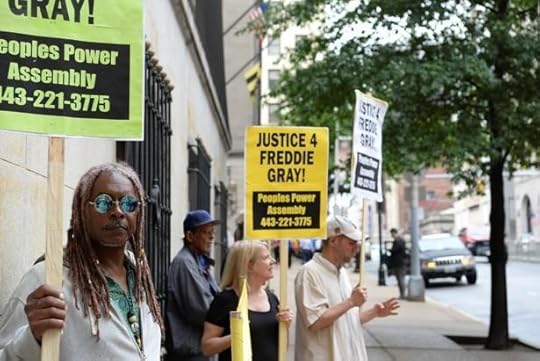
NEWS BRIEF A judge in Baltimore has dealt yet another setback to the beleaguered case against officers in the death of Freddie Gray.
Judge Barry Williams on Monday tossed out an assault charge against Lieutenant Brian Rice after prosecutors rested on the third day of Rice’s trial. Rice, who initially spotted Gray and ordered officers to chase him the day he was arrested, is the highest-ranking officer of the six charged in the case. Rice still faces charges of manslaughter, reckless endangerment, and misconduct. Gray, a 25-year-old black man, died in April 2015 after being mortally wounded while riding in a police van.
Pros. had to show Rice used van as instrument of assault at time he put Gray in van. Judge says no evidence Rice did that. Assault dismissed
— Paul McGrew (@McGrewFox45) July 11, 2016
Amid riots after Gray’s death, Baltimore City State’s Attorney Marilyn Mosby quickly brought charges against the six officers, winning praise from activists but condemnation from police and wariness from some legal observers. Those hesitations have been borne out: Prosecutors have struggled badly so far. The first trial ended up in a hung jury, though the state’s attorney plans to retry the case. The next two have ended with acquittals, including the trial of Officer Caesar Goodson, who was charged with second-degree depraved-heart murder, the most serious charge. Rice, like Goodson, has opted for a bench trial, in which the judge pronounces the verdict, rather than a jury hearing the case.

Make It or Break It Is Pre-Olympics Gold
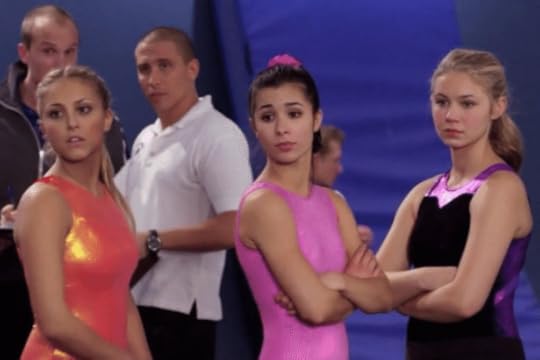
This weekend, a group of young women—girls, they might be called in another context, in their teens and early 20s—competed to become part of the U.S. Olympic gymnastics team. In the end, the five selected to represent the U.S. in Rio were Gabby Douglas and Aly Raisman, returning to the sport after their gold-winning efforts in London; Simone Biles, the all-around world champion for three years running; Laurie Hernandez; and Madison Kocian. (Ashton Locklear, MyKayla Skinner, and Ragan Smith will be alternates.) This was the team that was expected to result before the trials started; the young women are, given their strengths and their particular mix of talents and skills, are favorites to win all-around gold.
Related Story
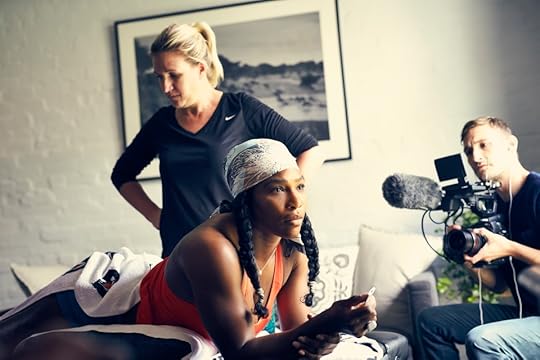
Serena Is a Compelling Portrait of Greatness
For viewers, women’s gymnastics is steadfastly popular because of the juxtapositions the sport offers: It is a tangle not just of sport and artistry, but also of youth and adulthood, of preparation and spontaneity, of physical strength and more more ephemeral femininity. (“Don’t cry,” one of the athletes admonished another on Sunday night after a particularly spectacular performance. “You’ll ruin your makeup.”) They’re collisions—all that human stuff, balancing and vaulting and glittering—that make you want to know the backstories of each athlete. And while NBC will surely supply those stories in August, in the form of the treacly mini-documentaries that accompany the competition, in the intervening weeks there is a very good stand-in: Make It or Break It, the gymnastics-themed drama that aired on ABC Family (now renamed Freeform) from 2009 to 2012. The show is, essentially, the heavily fictionalized version of what played out this weekend.
Make It or Break It, which is now available on both Freeform and Hulu, among other platforms, is a typical teen-focused soap opera: Think Pretty Little Liars, but with leotards. It focuses on a small group of elite gymnasts who train at the Rocky Mountain Gymnastics Training Center (“The Rock”), a Colorado-based gym known as a feeder for the Olympics. There’s Payson Keeler (Ayla Kell), a powerhouse who’s the favorite to win gold; Kaylie Cruz (Josie Loren), wealthy and charismatic, who is particularly talented as a tumbler; and Lauren Tanner (Cassie Scerbo), the quintessential mean girl who is, within The Rock and perhaps the world, “queen of the beam.”
It’s Pretty Little Liars, with leotards.
Together, the teenagers are expected to head to the Olympics—three members of what their coach expects will be the greatest U.S. Olympic team of all time—and they are all doing their part to fulfill that expectation. Until, that is, their longstanding plans are disrupted by a newcomer, Emily Kmetko (Chelsea Hobbs), a bundle of talent in need of training who has come to The Rock by way of a series of scholarships. Early on in the show’s first season, the typical dynamics of tween-focused soap operatics kick in: Will Emily’s arrival cause tensions? Will Lauren, the schemer, do whatever she can to stay on top? Will pathos both human and athletic coincide in the form of dramatic gymnastics meets? Yes. And yes. And yes.
Make It or Break It is not, to be clear, a great TV show, in the manner of the prestige stuff viewers are accustomed to today. (It is, as The A.V. Club put it, “not high art. It’s not even really middle art. More than anything, it’s probably what one would call a guilty pleasure, if one was predisposed towards feeling guilt over their entertainment choices.”) It is also, in the year of Simone Biles and Gabby Douglas and Laurie Hernandez, disappointing in its lack of diversity. And yet: It is compelling. It is addictive. That’s because of the smaller-scale tensions that it explores—the ones that result from the human pressures that face a collection of young women who carry the hopes of so many people on their muscular shoulders. This is a show that takes the cares of its young protagonists seriously.
Make It or Break It is frank about eating disorders, and about self-esteem, and about the financial costs of elite training, and about the social sacrifices that training demands of girls who are otherwise typical teenagers. In its universe, the moral lessons of, say, Twilight—a series at the height of its cultural influence when Make It or Break It arrived—are rendered especially (you could almost say absurdly) poignant: For these athletes, romance in general and sex in particular can compromise one’s career in an instant, via either lost focus or an unplanned pregnancy. (In an especially ironic twist, Chelsea Hobbs, who played Emily and who was 24 at the time the show premiered, got pregnant during filming—a particular challenge for a show that emphasizes its cast’s bodies, and that caused her, as a result, to leave Make It or Break It after the second season.)
But the show, in an elegant fusion of the structure of the soap opera and the realities of sports competition, is perhaps at its most compelling in its emphasis on the networked aspects of elite athleticism. Here are young women whose families and colleagues and coaches are relying on them, financially and otherwise, to succeed in their short “careers.” (As Lauren’s smarmy father sums it up: “They’re not little girls; they’re big business.”) And here, too, are girls who share the camaraderie of sacrifice: They are members of the very small group who understand what it means to give up so much of their childhoods to a single dream.
Gymnastics is exhilarating to watch not just because of the way its events defy gravity, but also because of its on-the-ground realities. In competition, all the work and the want and the sacrifice gets distilled down to a single grasped bar, a single flip of the torso, a single landing. Make It or Break It understands all that, in that sense makes for nice viewing in the run-up to its real-world counterpart. The show knows, perhaps even better than the Olympics’ producers do, that while gymnastics may be a team sport, in practice it is an individual one: one person, one moment, one shot. One longstanding dream that can be realized, or shattered, in an instant.

Atlantic Monthly Contributors's Blog
- Atlantic Monthly Contributors's profile
- 1 follower



